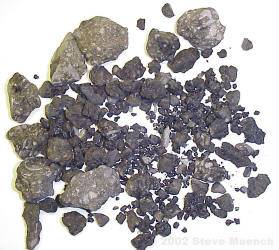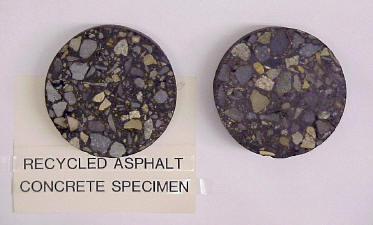Reclaimed Asphalt Pavement (RAP)
RAP is essentially old pavement that is reclaimed for use. In its most common form, it is collected in loose granular form as a byproduct of pavement rehabilitation or reconstruction (see Figures 1 and 2). RAP can be used in a variety of ways such as:
- As an addition to regular HMA.
- As an aggregate in cold-mix asphalt.
- As a granular base course when pulverized.
- As a fill or embankment material.
RAP as a Constituent in HMA
The most common RAP use is as a constituent in HMA. Basically, new HMA is produced at a batch or drum plant to which a predetermined percentage of RAP is added. There is ample evidence that HMA which incorporates RAP performs as well as HMA without RAP. The benefits of RAP use are two-fold:
- The RAP aggregate can be used in place of a portion of the virgin aggregate, which lowers cost and reduces waste.
- The RAP asphalt binder is reheated and used in place of a portion of the virgin asphalt binder, which lowers cost and reduces waste.
Figure 3 shows two dense-graded HMA cores, one with RAP and one without. If used, RAP is most commonly added at 10 to 30 percent by weight although additions as high as 80 percent by weight have been done and additions as high as 90 to 100 percent by weight are feasible (FHWA, 2001[2]). For mix design purposes,Superpave, Marshall or Hveem procedures can all be used. Blending charts are typically needed when using high percentages of RAP.
Other general considerations when using RAP are:
- When heated, RAP may give off gaseous hydrocarbons. To minimize these emissions, HMA plants generally heat RAP indirectly (usually it is added after the aggregate is heated and thus it heats up through contact with the already-hot aggregate).
- RAP is typically added cold and thus may require longer HMA plant heating times. This can sometimes reduce plant output by as much as half. This can be overcome by preheating RAP, but the added energy, equipment and emissions concerns often make preheating undesirable.
- RAP usually contains between 3 and 7 percent asphalt by weight or about 10 to 20 percent asphalt by volume (FHWA, 2001[2]). In general, the asphalt binder in RAP will be more viscous than virgin asphalt binder due to aging effects. Therefore, if enough RAP is added, a softer virgin asphalt binder should be used to counteract the more viscous RAP asphalt binder.
- After milling or crushing, RAP gradation is generally finer than pure virgin aggregate because of the degradation that occurs during removal and processing.
- In general, state DOTs allow more RAP in base courses than they do in surface courses.
Wednesday, 25 January 2012
//
Labels:
Engineering
//
0
comments
//
0 comments to "pavement: recycled Hot Mix Asphalt."
vfg
Search
About This Blog
Popular Posts
-
The Fuji Instax Mini 25 and Instax Mini 7S are a couple of moment picture zoom lens utilizing Fuji's Visa measured moment picture. In th...
-
When I pulled the Fujifilm Instax 200 out of my picture clicker pack at a familiar Sunday outing to a neighborhood small time baseball amuse...
-
The above picture is one of the most famous picture in the world. If you are the requester band Rage Against The Machine, the picture above...
-
The hotel room sports a modern yet cozy design and everything you need is provided for. The bed is super comfortable and remains the thing I...
-
Radisson - Blu Hotel , Berlin Germany is the world's largest cylindrical aquarium , named Aquadom . It is 25 meters ...
Feedjit















Post a Comment